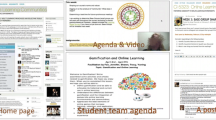Abstract
Colleges and universities are adopting learning communities to increase student learning and build cohesion. As learning communities grow in popularity, institutions need to invest in faculty development (Oates, 2001) and understand faculty experiences (Mullen, 2001). The University of Hartford created a program that prepared faculty for collaborative teaching in first-year learning communities. Faculty learned to engage in collaborative behaviors, to think outside disciplinary borders, and to employ a specific template as a heuristic for course development. Results of focus group research about the faculty experience and the impact of the experience on their pedagogy are summarized.
Similar content being viewed by others

References
Austin, A. E., & Baldwin, R. G. (1991). Faculty collaboration: Enhancing the quality of scholarship and teaching. (ASHE-ERIC Report, 7). Washington, DC: George Washington University.
Bruffee, K. A. (1993). Collaborative learning: Higher education, interdependence, and the authority of knowledge. Baltimore, MD: The Johns Hopkins UniversityPress.
Cotrell, P. G., & Millis, B. J. (1994). Complex cooperative learning strategies for college and university classrooms. In E. C. Wadsworth (Ed.), To Improve the Academy, 13 (pp. 285–307). Stillwater, OK: New Forums.
Duran, R. L., Colarulli, G., Barrett, K., & Stevenson, C. (2005). The next generation of learning communities: The University of Hartford first-year interest group model. Journal of the First-Year Experience and Students in Transition.
Eby, K. K. (2001). Teaching and learning from an interdisciplinary perspective. PeerReview, 3/4, 28–33.
Ehrman, S. C. (1998). Teaching, learning, and technology. In Paper presented at the 26th Annual FIPSE Project Directors’ Meeting, Washington, DC.
Gabelnick, F., MacGregor, J., Matthews, R. S., & Smith, B. L. (1990). Learning communities: Creating connections among students faculty and disciplines. In R. E. Young (Ser. Ed.), New directions for teaching and learning, 41. San Francisco, CA: Jossey-Bass.
Lennings, O. T., & Ebbers, L. H. (1999). The powerful potential of learning communities. (ASHE-ERIC Higher Education Report, 26). Washington, DC: The George Washington University.
Love, A. G. (1999). What are learning communities? In J. H. Levine (Ed.), Learning communities: New structures, new partnerships, for learning (Monograph Ser. No. 26, pp. 1–8). Columbia, SC: University of South Carolina, National Resource Center for The First Year Experience and Students in Transition.
MacGregor, J. (1991). What differences do learning communities make? In Washington Center News, 6 (pp. 4–9). Olympia, WA: Washington Center for Improving the Quality of Undergraduate Education.
Matthews, R. (1994). Enriching teaching and learning through learning communities. In T. O’Banion (Ed.), Teaching and learning in the community college. Washington, DC: American Association of Community Colleges.
Matthews, R. (1996). Learning communities: A retention strategy that serves students and faculty. Washington, DC: American Association of State Colleges and Universities.
Michaelson, L. K., Fink, L. D., & Knight, A. (1997). Designing effective group activities: Lessons for classroom teaching and faculty development. In D. Dezure (Ed.), To Improve the Academy, 16 (pp. 373–397). Stillwater, OK: New Forums.
Mullen, D. (2001). Assessing learning communities: Lessons learned. PeerReview, 3/4, 21–24.
Oates, K. (2001). Developing the faculty we need. PeerReview, 3/4, 9–13.
Pritchett, P. (1997). Teamwork: The team member’s handbook. Dallas, TX: Pritchard Associates.
Robinson, B., & Schaible, R. M. (1995). Collaborative teaching. College Teaching, 43, 57–59.
Shapiro, N. S., & Levine, J. H. (1999). Creating learning communities: A practical guide to winning support, organizing for change, and implementing programs. San Francisco, CA: Jossey-Bass.
Smith, B. L. (2001). The challenge of learning communities as a growing national movement. PeerReview, 3/4, 4–8.
Tokuno, K. (1993). Long-term and recent outcomes of freshman interest groups. Journal of the Freshman Year Experience, 2, 7–28.
Additional information
Catherine B. Stevenson, whose M.A. and Ph.D. are from New York University, is currently an Associate Professor of English and Drama and Academic Dean of International and Honors Programs. She and her coauthors are affiliated with the University of Hartford, West Hartford, CT. Her special interests include nineteenth and twentieth century literature, curriculum reform, pedagogy, and international education. Robert L. Duran, Professor in the School of Communication, who earned his M.A. at West Virginia University and Ph.D. at Bowling Green State University, is a specialist in program evaluation, evaluation research, and research methods. Karen A. Barrett, Associate Dean of Undergraduate Studies, has an M.S. from the State University of New York at Buffalo. Her special interests include interdisciplinary general education curriculum, higher education administration, and diagnostic hematology and microbiology. Guy C. Colarulli, earned an M.A. at the University of Connecticut and a Ph.D. at The American University. He is the Associate Provost and Dean of Undergraduate Studies, whose special interests include Higher Education Administration, First-Year Experience, as well as American Government, and Politics
Rights and permissions
About this article
Cite this article
Stevenson, C.B., Duran, R.L., Barrett, K.A. et al. Fostering Faculty Collaboration in Learning Communities: A Developmental Approach. Innov High Educ 30, 23–36 (2005). https://doi.org/10.1007/s10755-005-3293-3
Issue Date:
DOI: https://doi.org/10.1007/s10755-005-3293-3



